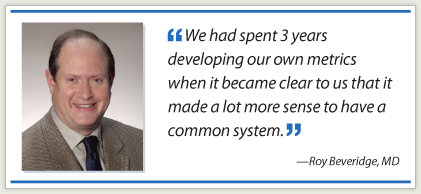The Quality Oncology Practice Initiative (QOPI®), ASCO’s quality measurement program, is entering its 6th successful year and continuing to grow, both in number of participants and in quality measures evaluated. In the truest spirit of quality improvement, ASCO’s oncologist leaders have determined that now is the time to move QOPI from a retrospective chart review process to an electronically based system that can interact with electronic medical records (EMRs).
“QOPI calls for a manual chart abstraction, a retrospective sampling of cases. We know we need to move forward and turn this into an electronic system where there’s as little manual data entry as possible, and data is collected in near-real time,” explained Allen S. Lichter, MD, ASCO Chief Executive Officer.
 As part of the lead-up to such a change, ASCO and US Oncology undertook a project to test whether data elements necessary for QOPI reporting were available and populated frequently enough from the iKnowMed EMR to generate QOPI reports.
As part of the lead-up to such a change, ASCO and US Oncology undertook a project to test whether data elements necessary for QOPI reporting were available and populated frequently enough from the iKnowMed EMR to generate QOPI reports.
Dr. Lichter noted that the iKnowMed EMR system was a great place to start this project, being a closed system with a large number of users. A substantial number of US Oncology practices have participated in QOPI.
Roy Beveridge, MD, Executive Vice President and Medical Director for US Oncology as well as Chief Medical Officer for McKesson Specialty Health, said working with ASCO was also a natural for US Oncology. “We were trying to determine whether we should do our own quality program, and we had spent 3 years developing our own metrics when it became clear to us that it made a lot more sense to have a common system,” he said. “We felt it was important to work with our national organization.”
Initial Foray: Transfer iKnowMed Data to QOPI
The first task for the project was to try to develop an automatic data transfer from iKnowMed into QOPI. Through QOPI, practices can benchmark their own cancer care data for improvement and compare performance with other similar practices across the country.
Dr. Beveridge headed up the joint ASCO–US Oncology task force that tested the feasibility of an automatic data transfer system. The challenge was that QOPI data must be structured text and not just captured in dictation. If QOPI data could transfer without manual intervention, the number of cases that could be monitored would greatly increase.
Collecting data from all patients rather than a sampling would greatly enhance the benchmarking numbers that come out of QOPI, Dr. Lichter commented. This sets the stage for measuring outcomes that could greatly aid oncologists in understanding targets for quality improvement. Looking at rock-solid outcomes data could also be helpful to oncologists when assisting patients in appealing denials from insurance companies regarding contentious coverage decisions.
In the pilot project, the task force found that data transfer was possible, but determined that automating transfer of all data needed for QOPI measures isn’t practical at present. The current QOPI system wasn’t designed for EMRs, and much of the information needed for QOPI abstraction doesn’t line up with structured data collected in an EMR. Neither ASCO nor US Oncology wants to create programs with negative workflow implications for oncology practices.
Dr. Beveridge added, “We can’t ask doctors to click an extra 57 or so boxes. We have to find a better approach.”
The first phase of the ASCO–US Oncology collaboration has helped identify a path forward. ASCO has learned a great deal from the collaboration and plans to initiate phase II of this endeavor.
Next? Redesign QOPI
The next step? To begin to create performance measurements for oncology care based on data that are captured through normal charting in an EMR. That means that QOPI measurements will need to be redesigned, said Dr. Lichter.
But creating a system for electronic transfer is definitely a worthy goal. More than 600 practices have participated in QOPI, with each chart requiring 30 to 60 minutes for practice staff to input. If QOPI can successfully go electronic, the time needed for a practice to input data would plummet, and the number of participating practices could grow substantially.
“We will learn to do this in a seamless way, and once we do, we’ll have the ability to take that concept to every other EMR inside oncology,” said Dr. Lichter. “That’s big, and that’s the long-range plan. Future collaborations with US Oncology will be of great help as we work toward a real-time, electronic version of QOPI.” ■
© 2012. American Society of Clinical Oncology. All rights reserved.

